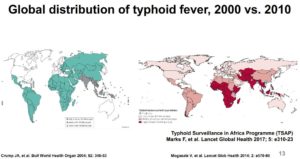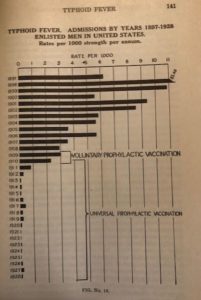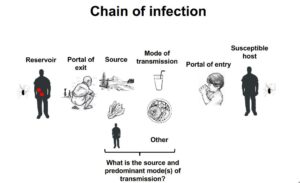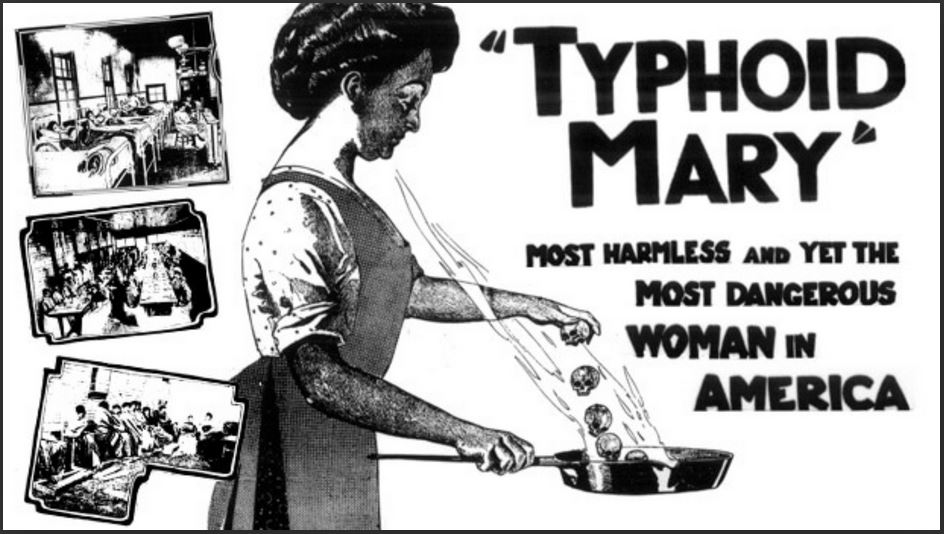Typhoid Mary, image obtained from: https://canadianfoodsafetytraining.com/2018/04/11/11075/
One week turns into two or even a month so quick…family visits, kids back to school, lacrosse tournaments, a very busy wife, my real job, oh and a small electrical fire. No kidding, apparently when the ground is not hooked up on the outside of your house electricity looks for a ground and melts/smokes/burns your cable lines. Luckily there was no real damage to the house, a couple blown breakers and our cable company had to install a new drop.
Today we continue our vaccination series with Typhoid Fever! Again, for me, this is one of those diseases that I think was pretty bad back in the day and is something that we really don’t have to think about now. It is my belief that we as a whole, all of American society, have generally forgotten how bad these diseases/viruses/bacteria really are. I think that is primarily due to a lack of perspective driven by our comfort and the fact that we take our medical advancements for granted. For perspective, John Adams once wrote :
“The smallpox is ten times more terrible than the British, Canadians and Indians together. This was the cause of our precipitate retreat from Quebec.” (emphasis mine)
Can you imagine a disease worse that the sum total of all of your enemies? In Two faces of death: fatalities from disease and combat in America’s principal wars, 1775 to present, Vincent J Cirillo states:
“Throughout America’s first 145 years of war, far more of the country’s military personnel perished from infectious diseases than from enemy action.”
How many you ask? Well that will cost you $20, but according to Wikipedia (where “other deaths” are defined as: “all non-combat deaths including those from accidents, disease, suicide, and murder”) there were 8,000 casualties in the American Revolution and 17,000 that died from other causes! In the Mexican-American war, there were 1,733 casualties and an estimated 11,550 deaths primarily due to disease! In our generation of warfare in Iraq and Afghanistan, again according to Wikipedia, there have been 5,669 combat deaths and just over 1,000 deaths from other causes. Can you imagine another 10,000-50,000 deaths from disease alone? Back to the Cirillo article:
“This enduring feature of war [death from disease] was finally reversed in World War II, chiefly as a result of major medical advances in prevention (vaccines) and treatment (antibiotics).”
In case you missed it, here is a link to our previous discussion on Yellow Fever and short background on why we are writing this series.
Disclaimer
From the U.S. Army Medical Department:
Immunization against disease is an important part of your medical readiness for worldwide deployment. The Soldier Medical Readiness Center screens your medical record and immunization record for documentation of receiving vaccination. If there is no documentation, we must assume you were never vaccinated.
The immune response protects the body against disease. Immunization is a means of triggering the immune response and providing long-lasting protections. With vaccination, you get protection from a specific germ or virus without ever suffering through the disease. Because the immune response may diminish over time, vaccines known as “boosters” are sometimes given to restore the immune response against a particular germ/virus.
The following is the current list of the vaccinations that the typical Army recruit gets when for their medical readiness.
Hepatitis B Vaccine
Hepatitis A Vaccine
Influenza Vaccine
Measles, Mumps, and Rubella (MMR) Vaccine
Inactivated Polio Vaccine
Tetanus-Diphtheria-Pertussis Vaccine
Typhoid Fever Vaccine
Tuberculosis Screening
Meningococcal Vaccine
Where one deploys will determine what additional vaccines that you may require prior to departure. Each region has its own list but for the sake of brevity, I am going to combine all of the lists into one and not repeat the vaccines that are required in multiple areas of operations. The additional vaccines from Health.mil:
Chickenpox Vaccine
Pneumococcal Vaccine
Rabies Vaccine
Anthrax Vaccine
Influenza Northern Hemisphere (NH)
Influenza Southern Hemisphere (SH)
Japanese Encephalitis
Smallpox
Today, we will discuss:
Typhoid Fever
From Health.mil (emphasis mine):
Typhoid fever is a life-threatening illness caused by the bacterium Salmonella Typhi. An estimated 5,700 cases occur each year in the United States. Most cases (up to 75%) are acquired while traveling internationally. Typhoid fever is still common in the developing world, where it affects about 21.5 million people each year.
An interesting thing that I noticed while researching for this article is how different the maps are. I thought it would be pretty straight forward but depending on when the map was created, the data varies a lot more than what I thought indicating very large regional outbreaks changing the data from year to year.

Fig. 1 Typhoid Fever Global Distribution obtained from: https://www.who.int/immunization/sage/meetings/2017/october/2_Crump_Typhoid_SAGE_16Oct2017.pdf?ua=1
History
The poster girl for typhoid fever is Mary Mallon or more commonly known as Typhoid Mary. Her fame, or infamy, is international as the Canadians still use her in public service announcements on food safety.
Here is a story about a famous carrier called Typhoid Mary who carried typhoid and killed the people she fed by practicing bad hand hygiene.
From 1900 to 1907, Mary Mallon worked as a cook in New York for several families. In 1906, she took a position in Oyster Bay, Long Island, within two weeks 10 of the 11 family members were hospitalized with typhoid. She changed jobs again, and similar occurrences happened in three more households.
The Public Health Department finally caught up with her, she was ordered to never cook for the public again. Malone changed her name and continued to cook for the public. Eventually the Health Department found her again and arrested her.
Not only was Mary Mallon ordered to never cook for the public again, she was declared a menace to society!
Mallon refused to believe what the doctors told her and declined their offers to remove her gallbladder (thought at the time to be the source of her typhoid shedding). So she was declared a menace to society and sent to live in isolation on North Brother Island, between the South Bronx and Rikers Island in the East River.
Even though I really enjoy reading this type of stuff I did not know the entire story of Typhoid Mary. For a very detailed look at her life follow this link at ThoughCo. Here are some interesting tidbits:
Mary Mallon was taken by force and against her will and was held without a trial. She had not broken any laws. So how could the government lock her up in isolation indefinitely?
That’s not easy to answer. The health officials were basing their power on sections 1169 and 1170 of the Greater New York Charter:
“The board of health shall use all reasonable means for ascertaining the existence and cause of disease or peril to life or health, and for averting the same, throughout the city.” [Section 1169]
“Said board may remove or cause to be removed to [a] proper place to be by it designated, any person sick with any contagious, pestilential or infectious disease; shall have exclusive charge and control of the hospitals for the treatment of such cases.” [Section 1170]
She was eventually released on the promise that she would not cook again but was recaptured five years later.
Feeling healthy, Mallon still did not really believe that she could spread typhoid. Though in the beginning, Mallon tried to be a laundress as well as worked at other jobs, for a reason that has not been left in any documents, Mallon eventually went back to working as a cook.
In January of 1915 (nearly five years after Mallon’s release), the Sloane Maternity Hospital in Manhattan suffered a typhoid fever outbreak. Twenty-five people became ill and two of them died. Soon, evidence pointed to a recently-hired cook, Mrs. Brown—and Mrs. Brown was really Mary Mallon, using a pseudonym.
Read the whole article, it is truly fascinating. An interesting thing to note, is that it is not easy to determine how many people she really infected. For that I had to turn to this excellent National Geographic article:
During the course of two outbreaks, at least 51 people caught typhoid through Mallon, and three died.
Interestingly this was over a 15-year period from 1900-1915. I do not say this to downplay the severity of typhoid fever. Only to note how long she was a spreader and to show how uncertain things were then. A little more history on the disease from Yolanda Smith writing for News-Medical: (emphasis mine)
Some historians believe that typhoid fever was responsible for a widespread plague in Athens in 430BC, which proved fatal for one third of the population, including the leader at the time, Pericles. His successor, Thucydides, also contracted the same disease, although it did not prove fatal.
Jamestown, an English colony in Virginia, is also thought by some historians to have died out as a result of typhoid fever. The fever proved fatal for more than 6000 settlers between 1607 and 1624, and may have been responsible for eliminating the entire colony.
Military and war environments have often been subjected to the presence of typhoid fever throughout history. In excess of 80,000 soldiers died as a result of typhoid fever or dysentery in the American Civil War. Likewise, the Spanish-American War led to infections with typhoid both on the field and in training camps.
Not that you needed any more proof for how big of a nerd I am, I consulted my 1931 Military Preventive Medicine Manual to gain a perspective on the thinking of the time. This manual was produced just over 20 years after prophylactic vaccination began in the U.S. Military.
During the World War, [WWI, WWII had not happened yet!] there were 1529 admissions to hospital for typhoid fever among approximately 4,000,000 troops, or an annual rate of 0.37 per 1000 strength.
The following chart demonstrates that effectiveness of the vaccine, both voluntary and universal, in a rate per 1000.

Figure 2: Typhoid Fever. Admissions by years 1897-1928 obtained from: Military Preventive Medicine by George C. Dunham, Major Medical Corps, U.S. Army
Signs and Symptoms
Make no mistake, Typhoid Fever is deadly, according to the Encyclopedia Britannica, “If untreated, typhoid fever proves fatal in about 10 to 30 percent of all cases.” So, what are the signs and symptoms of Typhoid Fever? From the Mayo Clinic:
Early illness
-
- Fever that starts low and increases daily, possibly reaching as high as 104.9 F (40.5 C)
- Headache
- Weakness and fatigue
- Muscle aches
- Sweating
- Dry cough
- Loss of appetite and weight loss
- Abdominal pain
- Diarrhea or constipation
- Rash
- Extremely swollen abdomen
Later illness
If you don’t receive treatment, you may:
-
- Become delirious
- Lie motionless and exhausted with your eyes half-closed in what’s known as the typhoid state
In addition, life-threatening complications often develop at this time.
In some people, signs and symptoms may return up to two weeks after the fever has subsided.
If that doesn’t sound bad enough for you how about these complications, again from the Mayo Clinic:
Intestinal bleeding or holes
The most serious complications of typhoid fever — intestinal bleeding or holes (perforations) in the intestine — may develop in the third week of illness. A perforated intestine occurs when your small intestine or large bowel develops a hole, causing intestinal contents to leak into your abdominal cavity and triggering signs and symptoms such as severe abdominal pain, nausea, vomiting and bloodstream infection (sepsis). This life-threatening complication requires immediate medical care.
Other, less common complications
-
- Inflammation of the heart muscle (myocarditis)
- Inflammation of the lining of the heart and valves (endocarditis)
- Pneumonia
- Inflammation of the pancreas (pancreatitis)
- Kidney or bladder infections
- Infection and inflammation of the membranes and fluid surrounding your brain and spinal cord (meningitis)
- Psychiatric problems, such as delirium, hallucinations and paranoid psychosis
With prompt treatment, nearly all people in industrialized nations recover from typhoid fever. Without treatment, some people may not survive complications of the disease.
How is it Transmitted
According to the WHO,
The typhoid bacillus is transmitted by consumption of contaminated food or water. Occasionally, direct faecal–oral transmission may occur. Shellfish taken from sewage-polluted areas are an important source of infection; transmission also occurs through eating raw fruit and vegetables fertilized by human excreta and through ingestion of contaminated milk and milk products. Flies may cause human infection through transfer of the infectious agents to foods. Pollution of water sources may produce epidemics of typhoid fever when large numbers of people use the same source of drinking-water.
For a visual depiction of the mode of transmission we can reference the work of John A. Crump, MB ChB, MD, DTM & H McKinlay Professor of Global Health with the University of Otago. (Really I just wanted to have a reason to use this slide that has an image of a surface sh#$%r in it!)

Fig 3. Typhoid Fever chain of infection created by John A. Crump, MB ChB, MD, DTM & H McKinlay and obtained from: https://www.who.int/immunization/sage/meetings/2017/october/2_Crump_Typhoid_SAGE_16Oct2017.pdf?ua=1
Here is another image from my 1932 Preventive Medicine Manual in regards to the control of intestinal diseases.

Figure 4: General factors involved in the control of intestinal diseases obtained from: Military Preventive Medicine by George C. Dunham, Major Medical Corps, U.S. Army
Diagnosis
The Mayo Clinic states that the diagnosis is based on your medical and travel history.
Your doctor is likely to suspect typhoid fever based on your symptoms and your medical and travel history. But the diagnosis is usually confirmed by identifying Salmonella typhi in a culture of your blood or other body fluid or tissue.
Treatment
Antibiotics are the only known treatment for typhoid.
Commonly prescribed antibiotics include:
-
- Ciprofloxacin (Cipro). In the United States, doctors often prescribe this for nonpregnant adults. Another similar drug called ofloxacin also may be used. Unfortunately, many Salmonella typhi bacteria are no longer susceptible to antibiotics of this type, particularly strains acquired in Southeast Asia.
- Azithromycin (Zithromax). This may be used if a person is unable to take ciprofloxacin or the bacteria is resistant to ciprofloxacin.
- Ceftriaxone. This injectable antibiotic is an alternative in more-complicated or serious infections and for people who may not be candidates for ciprofloxacin, such as children.
Vaccine
Yes please! The vaccine in administered by an intramuscular (IM) shot or orally. The IM dose is 0.5ml every 2 years. Orally, the vaccination is good for five years and consists of 4 capsules taken on day 1,3,5 and 7. You must complete the vaccination 1-2 weeks prior to travel so it has time to take effect. Taking antibiotics will not prevent an infection and should only be use to treat one.
Side Effects of the Vaccine
Honestly, I don’t care, and according to the U.S. Army’s Medical Department there are no listed side effects!
Conclusion
Again, the purpose of this post is not to draw parallels to the current COVID19 pandemic. It is for awareness only. I wanted to provide some background on some of the diseases that we are vaccinated against and also to serve as a reminder of how dangerous the world once was. Consider the fact that in some instances there were 2-10 times more people killed from disease than casualties in war! Typhoid Fever, while primarily limited to the developing world, is a disease that has the potential to impact many lives and should be take seriously. I hope that the next time that you go in for a vaccination you remember a small portion of this article and better understand the why behind each shot you are given. Next week: the Measles, Mumps and Rubella vaccine.

